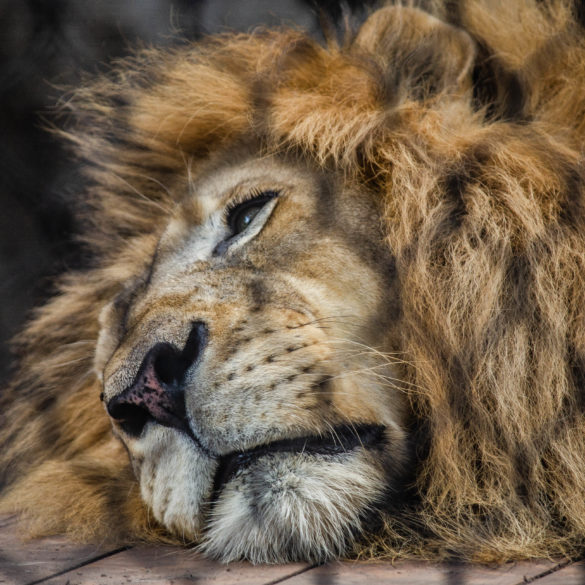Over the past two centuries, zoos have evolved from places for flaunting wealth to centers of learning and preservation.
One summer day at the Fort Wayne Children’s Zoo, Erin Roembke was preparing to teach a group of visitors about the honey badger. But before she could begin, a young boy from the crowd spoke up.
What are their names? he asked, eyes wide with interest.
Their names are Sandy and Reilly, Erin said.
Do they have a favorite food?
Reilly prefers rats, and Sandy prefers smelt, Erin replied.
Interacting with curious guests is a key aspect of Erin’s job as a zookeeper. She works with African primates and carnivores, and her specialties include bat-eared foxes, banded mongooses, honey badgers, and radiated tortoises. After a few years years connecting with these animals, Erin has come to think of them as family.
Bonnie Kemp, the Fort Wayne Children’s Zoo’s director of communication, says the zoo aims to get visitors thinking about preserving nature and saving wild animals. The staff tries to create a fun and educational experience for its guests, with a strong focus on appealing to youth.
This sort of conservation-based mission is common among zoos today, but that hasn’t always been the case.
People have been keeping collections of wild animals for centuries, according to National Geographic’s encyclopedia. The first appearances of places resembling zoos date back to 2500 BCE. These “menageries” were often private spaces designed to show off the wealth of aristocrats.
Nationally, the first zoo resembling what we see today opened in Paris in 1793. In 1874, the first zoo in the United States opened in Philadelphia.
From the mid-1800s to the mid-1900s, zoos aimed to provide a recreational experience for visitors to view animals from all over the world.
By the mid-1830s, zoos became more public, open to more than just those of a wealthier status. The animals were kept in small, barred cages with little vegetation. One of the main concerns during this time was disease, and small cages were the easiest to clean.
There wasn’t an educational component to the experience until the 1970s, when the animal habitats in zoos started to be re-invented. Seattle’s Woodland Park Zoo was considered to have the first immersive exhibit. These environments were larger and contained more decorative features, such as artificial rocks and eye-catching backdrops.
Today, zoos have evolved to become places of conservation and education. They promote sustainability and strive to teach audiences of all ages about wildlife.
Gary Dodson, a professor emeritus of biology at Ball State University, thinks a perfect world would not have any animals in captivity. But when it comes to the conservation of endangered species, he says zoos are the best option. Dodson says zoos typically have breeding programs designed to expand the population of endangered animals. But zoos will never go away, Dodson believes, because it can be dangerous for animals bred in captivity to enter the wild.
Even though Dodson doesn’t see a future without zoos, he says we can still help preserve existing wildlife through sustainability efforts.
The Fort Wayne Children’s Zoo raises money to protect wild animals, with a portion of each ticket sale going toward local and global conservation projects. The zoo also works toward sustainability efforts and educates guests on how they can help protect wildlife.
Erin says one way the zoo increases guest interaction is by having only a glass barrier between the humans and the animals, which appeals especially to younger children.
“This gives them a very real connection to the animals and makes their experience at the zoo memorable,” Erin says. “I love seeing the youth of tomorrow walk away with a valuable experience.”
After a day at the Fort Wayne Children’s Zoo, guests who interact with Erin know that the honey badger has an average lifespan of 20 years in captivity and eight years in the wild. Visitors also learn that mongooses might look approachable but are not tame.
The zoo extends its mission beyond everyday visitors by hosting the Kids for Nature Summer Camp each year. This week-long program allows elementary students to explore the zoo and learn about sustainability and conservation.
The zoo also has a team of instructors who visit local classrooms, teaching students about conservation, zoo animals, and wild places, according to Kemp.
When choosing which conservation projects to fund, the zoo grants its members the opportunity to vote on their favorite conservation project. Kemp says this year, they can vote for African lions, Javan gibbons, or migratory songbirds.
The Fort Wayne Children’s Zoo also works towards sustainability efforts through a variety of measures, such as recycling and planting pollinator and rain gardens. Each year, more than 200 tons of organic material from the zoo are hauled to Fort Wayne’s Biosolids facility and turned into compost. The zoo also has a storm water unit to help keep waste and debris out of the local watershed.
Erin tries to make sure zoo visitors leave with a deeper appreciation for the animals they see there. She also hopes spending time at the zoo, watching nature up-close and learning about conservation, might give people a better idea of what they can do to help protect wildlife.




